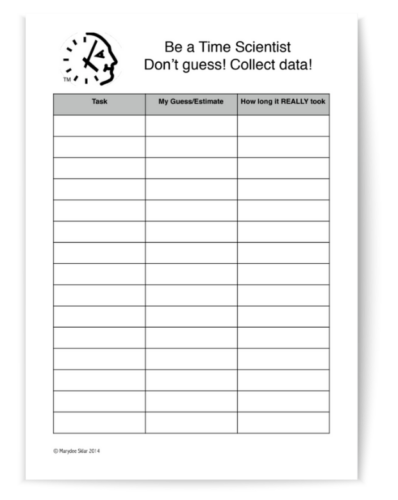Do you constantly run out of time when you start tasks? Are you surprised when things take you a lot longer than you anticipated?
If so, you are probably aware that your brain struggles with the executive function skill of time management: the ability to gauge one’s available time, allocate it effectively, and adhere to deadlines.
This is not an easy skill to cover up or “mask”. Getting behind on task completion results in conflicts with coworkers, family members and teachers. And it adds to your own stress load – often in a major way.
Time management is a challenge that many of my private Seeing My Time® clients face.
You might be surprised to hear that the solution is not to “be more productive” or “hustle” more, but to reframe how you think about time and tasks to lower your stress level.
Here are three wonderful ways to do that:
Step One: Collect Data
In my experience, most people are awful at estimating how long it will take to do things. To-do lists that don’t ever get crossed off are sure signs of people who are overly optimistic about fitting things into their day.
The truth is that you will never get better at time management unless you collect data. You need concrete, written records of how long things take you to complete. You need to become a “Time Scientist”! For a week or two, record just about everything that you do.
I’m talking about showers, getting dressed, making beds, cooking hamburgers for dinner, doing dishes, folding laundry, getting to work, completing standard work tasks, etc.

Don’t count on your brain to store this information – write it down! Use any old piece of paper, or our Time Scientist form.
Once you have collected enough data, look – really look – at the form. Do you see any recurring patterns? Learn from this information and take it forward as you move through the world.
A great way to help your brain interpret this new data is to use what I call time circles. These are simple, small, drawn symbols that represent the spatial aspect of time. Use a fully colored in circle for an hour, a half colored in circle for a half hour, etc.
Predicting this visual data across your day’s activities will help you set doable expectations for your day.
Step Two: Become a “Pessimistic Realist” with Projects
When facing a new unfamiliar task that is full of steps, we tend to be overly optimistic.
“It can’t take that long…” we say.
This often occurs around tasks like remodeling or “simple” home repairs you undertake to save money, such as painting a bedroom. Our work lives are often full of new projects of all kinds, with multiple components with very specific deadlines.
And of course, school settings are full of project deadlines that are required to successfully complete a class with a good grade.
So, rather than be optimistic in these situations, I encourage you to be pessimistic. Eons ago I read some time management guru’s advice about planning for projects. He said to make your best guess and then multiply that number by three.
Yup, you read that correctly. Expect the project to take three times as long to complete as you would like.
I am here to tell you that I have found that awful insight to be true more times than not. But it has helped me to be more realistic about my expectations for finishing projects, and to adapt accordingly – especially when it comes to managing projects like home renovations.
In fact, sometimes multiplying by three isn’t enough. For more complicated projects, I use my Seeing My Time Adult Planner System planning pages to plan, consider and be realistic about my hours to work on it.

Step Three: Use Your “Found Time” Wisely
The good news is that not all worst-case scenarios come true. Sometimes you will actually complete something sooner than expected. Hallelujah! You just got a gift of time. Now, don’t waste it!
Rather than jumping down the rabbit hole of phone or screen time, use that “found time” to do a few quick tasks that will allow you more freedom in your evening. Or spend it doing something fun that will support your brain: taking a walk, connecting with a friend, or doing something that brings you joy.
A client of mine was a specialty surgeon. We were analyzing the challenges of scheduling sufficient time for procedures with his patients. Typically the time he allotted was enough, but when there were complications, that procedure could eat up a lot of extra time and put a crunch into the rest of the day’s appointments, impacting waiting patients.
It also added stress for his staff and the rest of the surgical team as they nervously watched the clock.
The solution we came up with was to have all of the procedures scheduled for a “worst-case scenario” amount of time.
If all of the time wasn’t needed, he would then use that extra time to write up his case notes and do other bits of administrative work that needed to get done each workday. The benefit of wisely using his “found time” is that he was no longer taking work home to complete after dinner! This small change hugely befitted his work and staff, his family’s life and his own stress level.
You have to remember that time management is a misnomer. You can’t “manage” time. Time is a constant.
All we can do is to manage our expectations and adjust our behaviors, our choices. By following those three steps you will be able to end your day not with a sense of failure, but a sense of accomplishment. It can be done!
Little by little…


